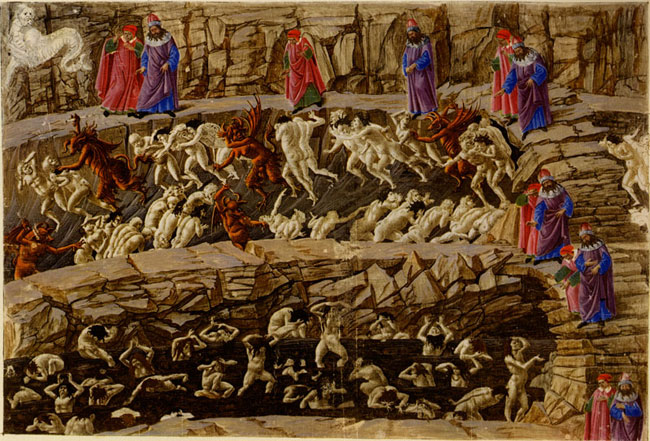
There are plenty of things to say about Canto 18. It's been nicknamed the Maleboge, which deliciously translates as "Evil Pouches". Dante describes the architecture of this circle as concentric circles that naked sinners are marching, and it harkens to moats of castles. The sinners march is in direct response to the jubilee that Dante witnessed wherein Pope Boniface VIII introduced that oh so heretical trend from medieval times called "indulgences" (i.e. the church enabling sinners to purchase an indulgence, which would remove a sin from their soul). Jason, from the famed Jason and the Argonauts fable, is present. Yes there are some wonderfully interesting things here. But I wanted to veer from my own proverbial rut to examine a painting of ruts.
The picture above was created by the renaissance master, Sandro Botticelli. He is best known for his masterpiece "Venus in a Clamshell", but his illustrations for the divine comedy are a remarkable achievement. What strikes me, and I am no art critic, is the use of color in the composition. There is a striking dispersement of vibrant reds and blues amongst the flat pallatte of browns and yellows which represent the sinners and their prison. The demons harassing the sinners in the trench are terrifying in their uniqueness. They range from a minotaur, to a kind of reverse centaur with the head of a horse on the winged body of a man, to the most detailed of the demons looking very much like I would imagine the harpies from the suicide forest. We the viewers are looking at a static painting that Boticelli clearly wanted to portray a moving image. The figures of Dante and Virgil are represented in 6 distinct locations. Most interestly of these representations is the one closest to the vantage point. It is the only place in the painting where there is noticable space separating Dante and his guide. Dante looks transfixed on the horrors below him, while virgil appears to be pensively praying, perhaps futiley hoping for the end of the eternal torment on display below him. It is also the only representation of Dante where he doesn't seem to visibly recoil. His expression is one of fascination, not fear. And what to make of the ghostly apperation in the top left corner. It looks like a manticore, or some variation on another mythical beast. The figure has certainly spooked Dante, whose stance is clearly one of terror.
This painting has a glorious depth and motion to it. There is a gripping sense of fear, perpetual agony, and a vibrant separation between those receiving, inflicting and observing torture. Boticelli has captured the essence of Inferno like few others, regardless of the medium, have.
No comments:
Post a Comment